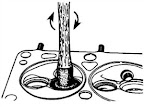Ford OHV engine cylinder head and pistons decarbonising - is a part of Ford repair manuals: Ford OHV Engines. This part contains the detailed description and diagrams for Ford OHV engine cylinder head and pistons decarbonising.
- With Ford OHV engine cylinder head removed, the carbon deposits should be removed from the combustion spaces using a scraper and a wire brush fitted into an electric drill. Take care not to damage the valve heads, otherwise no special precautions need be taken as the cylinder head is of cast iron construction.
- Where a more thorough job is to be carried out, the cylinder head should be dismantled so that the valves may be ground in and the ports and combustion spaces cleaned, brushed and blown out after the manifolds have been removed.
- Before grinding in a valve remove the carbon and deposits completely from its head and stem. With an inlet valve, this is usually quite easy, simply scraping off the soft carbon with a blunt knife and finishing with a wire brush. With an exhaust valve the deposits are very much harder and those on the head may need a rub on coarse emery cloth to remove them. An old woodworking chisel is a useful tool to remove the worst of the head deposits.
 - Make sure that the valve heads are really clean, otherwise the rubber suction cup of the grinding tool will not stick during the grinding in operations.
- Make sure that the valve heads are really clean, otherwise the rubber suction cup of the grinding tool will not stick during the grinding in operations.
- Before starting to grind in a valve, support the cylinder head so that there is sufficient clearance under for the valve stem to project fully without being obstructed.
- Take the first valve and apply a little coarse grinding paste to the bevelled edge of the valve head. Insert the valve into its guide and apply the suction grinding tool to its head. Rotate the tool between the palms of the hands in a back-and-forth rotary movement until the gritty action of the grinding-in process disappears. Repeat the operation with the fine paste and then wipe away all traces of grinding paste and examine the seat and bevelled edge of the valve. A matt silver mating band should be observed on both components, without any sign of black spots. If some spots do remain, repeat the grinding-in process until they have disappeared. A drop or two of paraffin applied to the contact surfaces will increase the speed of grinding-in, but do not allow any paste to run down into the valve guide. On completion, wipe away every trace of grinding paste using a paraffin-moistened cloth.
- Repeat the operations on the remaining valves, taking care not to mix up their originally fitted sequence.
- Reassemble the valves to the cylinder head.
- An important part of the decarbonising operation is to remove the carbon deposits from the piston crowns. To do this, turn the crankshaft so that two pistons are at the top of their stroke and press some grease between these pistons and the cylinder walls. This will prevent carbon particles falling down into the piston ring grooves. Stuff rags into the other two bores.
- Cover the oilways and coolant passages with masking tape and then using a blunt scraper remove all the carbon from the piston crowns. Take care not to score the soft alloy of the crown or the surface of the cylinder bore.
- Rotate the crankshaft to bring the other two pistons to TDC and repeat the operations.
- Wipe away the circle of grease and carbon from the cylinder bores.
- Clean the top surface of the cylinder block by careful scraping.
from Ford repair manuals
